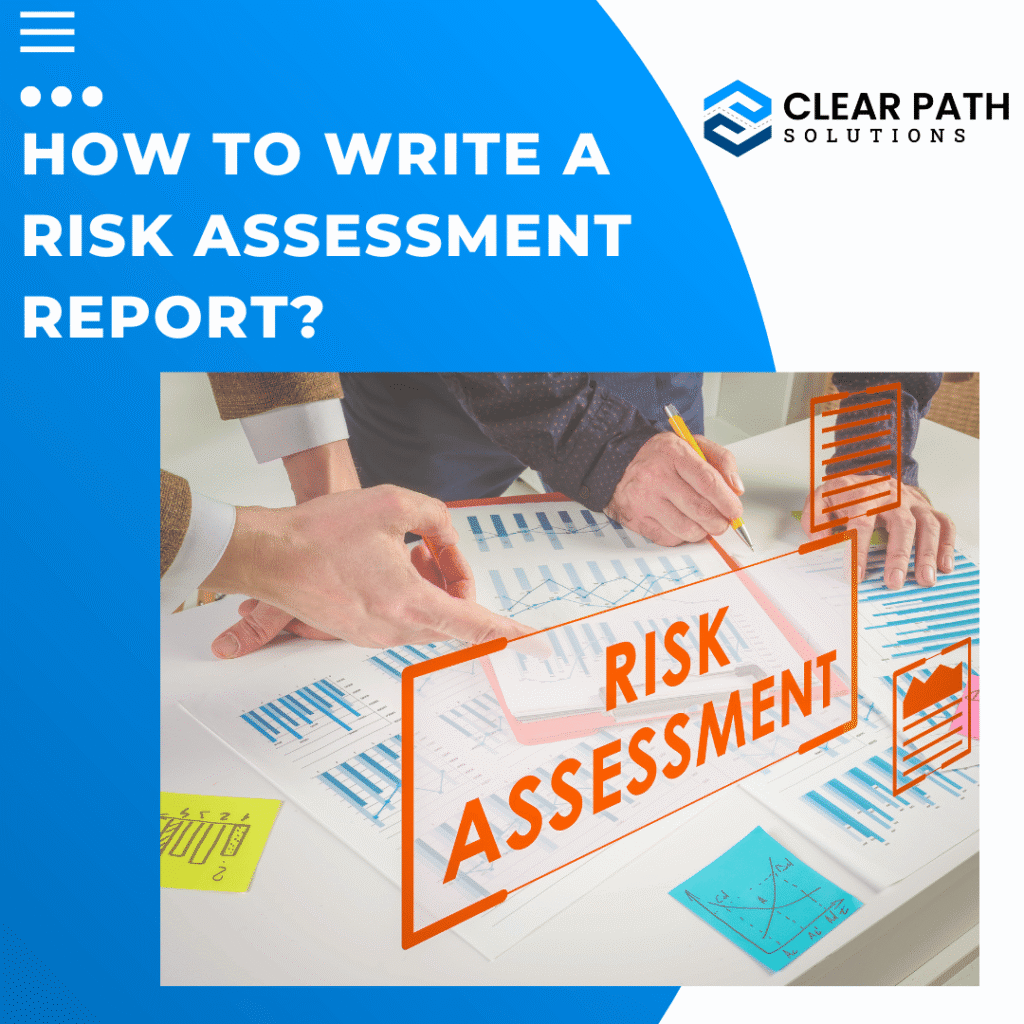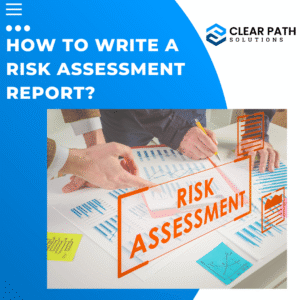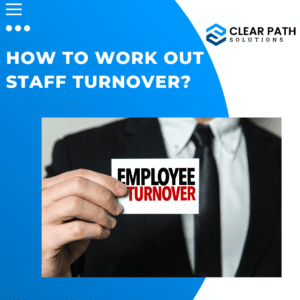Writing a risk assessment report is a crucial responsibility for employers, as it ensures workplace safety, legal compliance, and business continuity. Responsible ans successful business owners view it as not just a legal requirement — rather they consider it as a vital part of protecting employees, visitors, and the public.
A well-written risk assessment report helps identify workplace hazards, evaluate risks, and implement measures to keep everyone safe.
From a business perspective, effective risk assessment reporting also reduces the likelihood of accidents, legal claims, and reputational damage. By documenting risks and preventive actions clearly, employers can demonstrate due diligence, strengthen health and safety policies, and foster a safer, more productive work environment.
In this blog guide, we’ll walk you through how to write a professional risk assessment report that meets UK legal standards, is practical for day-to-day use, and supports a safe working environment.
What Is a Risk Assessment Report?
A risk assessment report is a documented record of your findings when you assess potential hazards in the workplace. It outlines:
- What could cause harm (hazards)
- Who might be harmed and how
- What you are already doing to control the risk
- What further action is needed
In the UK, employers have a duty under the Health and Safety at Work etc. Act 1974 and the Management of Health and Safety at Work Regulations 1999 to carry out risk assessments and record the findings if they have five or more employees.
Hence, a risk assessment report is a crucial formal document that identifies workplace hazards, evaluates the likelihood and severity of risks, and recommends control measures to prevent harm. It serves as evidence of due diligence, ensuring legal compliance, protecting employees’ well-being, and supporting employers in maintaining a safe, efficient work environment.
Why Risk Assessment Reporting is important for Employers?
From an employer’s perspective, a detailed risk assessment report:
- Demonstrates compliance with UK health and safety laws
- Protects against legal claims by proving due diligence
- Reduces the risk of workplace accidents and illness
- Improves employee confidence in safety measures
- Helps manage insurance requirements and premiums
Failing to carry out proper risk assessments can lead to fines, enforcement action, or even criminal prosecution. It is also one of the standard practices followed by all employers that demonstrates commitment to employee safety, builds trust, and enhances productivity by creating a secure environment where staff can work confidently without unnecessary risks.
Legal Requirements for Risk Assessments in the UK
Legally, employers are required to conduct and document risk assessments to comply with health and safety regulations. As an employer, you must:
- Identify hazards in the workplace.
- Decide who might be harmed and how.
- Evaluate risks and decide on precautions.
- Record your findings if you employ five or more people.
- Review and update your risk assessment regularly.
Additionally, industry-specific regulations may apply, for example in construction, manufacturing, or healthcare.
Step-by-Step Guide: How to Write a Risk Assessment Report
Writing a risk assessment report involves both practical observation and clear documentation. Here’s how to do it effectively.
- Define the Scope and Purpose: Defining the scope and purpose is the first and most critical step in preparing a risk assessment report. Setting clear boundaries ensures the assessment remains focused, thorough, and relevant. This step provides direction, avoids unnecessary complexity, and ensures all stakeholders understand the objectives, ultimately leading to a more effective and actionable risk assessment report.
Start by clarifying:
- Which area, process, or activity you are assessing
- Who will use the report
- The timeframe covered
Example: “This risk assessment covers the use of machinery in the production area at XYZ Ltd. It applies to all production staff and visitors between January and December 2025.”
- Identify Hazards: Identifying hazards is the second step in preparing a risk assessment report and forms the foundation of the entire process.
Walk around the workplace and note anything that could cause harm, such as:
- Physical hazards (machinery, slips, falls)
- Chemical hazards (cleaning agents, fumes)
- Biological hazards (bacteria, viruses)
- Ergonomic hazards (poor workstation design)
- Psychosocial hazards (stress, harassment)
Pro Tip: Speak to employees — they often spot risks that management misses.
- Decide Who Might Be Harmed and How: is the next essential step in preparing a risk assessment report. Employers must identify all groups who might be potentially at risk
For each hazard, consider:
- Full-time Employees
- Contractors
- Visitors
- The public
Example:
Hazard: Wet floor near entrance
Who might be harmed: Employees and visitors
How: Slips and falls leading to injury
Each hazard should be analyzed in terms of who could be exposed and the nature of possible harm—whether physical injury, illness, or psychological stress. Considering vulnerable groups, such as pregnant workers or those with health conditions, is also critical. This step ensures the assessment is inclusive, targeted, and focused on practical protective measures.
- Evaluate Risks and Decide on Precautions: This is a crucial step in preparing a risk assessment report, as it determines the likelihood and severity of identified hazards causing harm. Employers must assess each hazard’s potential impact, prioritize risks, and decide on practical control measures to minimize or eliminate them.
Assess:
- Likelihood of harm occurring
- Severity of harm if it happens
Use a simple risk rating system (e.g., Low, Medium, High). Then, decide what controls are in place and what additional measures are needed. This may include engineering controls, safer work practices, protective equipment, or training. The goal is to apply the hierarchy of controls—starting with eliminating risks where possible, then reducing or managing them effectively.
For Example:
Current controls: Warning signs placed near wet areas
Additional controls: Non-slip mats, regular floor inspections
- Record Your Findings : This is a vital step in preparing a risk assessment report, as it documents the identified hazards, the people at risk, and the measures taken to control those risks.
Your report should be clear, concise, and accessible. The Health and Safety Executive (HSE) advises including:
- Date of assessment
- Assessor’s name
- Description of each hazard
- Who is at risk
- Existing controls
- Risk rating
- Additional measures needed
- Target completion dates
- Responsible person for action
This written record not only provides transparency but also serves as evidence of compliance with legal requirements. It allows employers to communicate results effectively with employees, ensuring everyone understands the safety measures in place. A well-documented report also helps track progress, review effectiveness, and serves as a reference for future assessments or audits.
- Implement the Actions: This is the step where the risk assessment moves from planning to practical application. Once hazards and necessary precautions are identified, employers must put these control measures into action to reduce risks effectively. This could involve installing safety equipment, revising processes, providing training, or issuing protective gear.
Assign responsibilities and deadlines for the control measures you identified. Make sure staff are informed and trained where necessary. Clear communication with employees is essential to ensure they understand new procedures and comply with them.
- Review and Update Regularly: Review and upgrade is the final step in preparing a risk assessment report, ensuring it remains relevant and effective over time. Risks, workplace conditions, and legal requirements can change, so employers must regularly revisit the assessment to identify new hazards or gaps in existing controls. Reviews should occur after significant workplace changes, incidents, or at scheduled intervals. Updating the report allows employers to refine safety measures, strengthen compliance, and continually improve workplace safety standards. Involving employees during reviews helps capture practical insights. This ongoing process ensures the risk assessment stays proactive, reducing risks and supporting long-term organizational safety.
Workplaces change — new equipment, processes, or staff can introduce new hazards. Review your risk assessment:
- At least annually
- After significant changes
- Following an accident or near-miss
Sample Risk Assessment Report Template
| Hazard | Who Might Be Harmed | Risk Rating | Existing Controls | Additional Measures Needed | Responsible Person | Target Date |
| Wet floor in reception | Employees, visitors | Medium | Warning signs | Install non-slip mats | Facilities Manager | 10/09/2025 |
| Noise from machinery | Machine operators | High | Ear protection provided | Noise level monitoring | H&S Officer | 15/09/2025 |
Best Practices for Writing an Effective Risk Assessment Report
- Use plain English – Avoid jargon so everyone can understand.
- Be specific – “Wet floor near reception” is better than “floor hazard.”
- Involve employees – Collaborative assessments are more accurate.
- Prioritise high risks – Address the most serious hazards first.
- Keep it practical – Focus on realistic, actionable measures.
Common Mistakes Employers Should Avoid
- Copy-pasting generic templates without adapting to your workplace
- Failing to act on identified risks
- Overcomplicating the format so staff don’t read it
- Not reviewing regularly after workplace changes
- Ignoring employee feedback on hazards
Digital vs Paper-Based Risk Assessments
Digital vs paper-based risk assessments highlight the evolving approaches employers can use to manage workplace safety. Paper-based assessments are traditional, easy to start, and require no technology, but they can be time-consuming, prone to loss, and harder to update or share.
Digital risk assessments, on the other hand, offer greater efficiency, accuracy, and accessibility. They allow employers to store, track, and update reports easily while enabling real-time collaboration and compliance monitoring. Digital tools also reduce administrative burdens and provide analytics for better decision-making.
Many UK businesses are moving towards digital risk assessment tools for:
- Easier updates
- Centralised storage
- Automatic reminders for reviews
- Better compliance tracking
However, small businesses may still find paper-based reports adequate if properly stored and maintained.
While both methods serve the purpose, digital solutions increasingly prove more practical for modern organizations.
Why Employers Should Take Risk Assessment Reporting Seriously?
Beyond legal compliance, risk assessment reports:
- Show employees you value their safety
- Reduce downtime from accidents
- Lower the likelihood of legal disputes
- Enhance your business reputation with clients and regulators
Investing time in accurate reporting is far cheaper than dealing with the aftermath of preventable accidents. By prioritizing risk assessments, employers create safer workplaces, improve productivity, and establish a culture of responsibility that benefits both employees and the organization long term.
In conclusion, risk assessment reports are essential for creating a safe, compliant, and productive workplace. They guide employers in identifying hazards, protecting employees, and fulfilling legal obligations while minimizing financial and reputational risks. Choosing digital tools further enhances efficiency and accuracy.
Ultimately, effective risk assessments are an investment in both people and organizational success.
****************************
How Clear Path Solutions can help Employers in Risk Assessment Reporting?
While risk assessments are often led by health and safety teams, Clear Path Solutions as HR outsourcing Partner play an important role in ensuring compliance and consistency.
Our Team of Experts:
- Provide expert guidance on legal requirements
- Develop customised risk assessment templates for your business
- Train managers and staff in hazard identification
- Maintain documentation for audits and inspections
- Ensure reports align with broader HR policies, such as wellbeing and absence management
For any business especially, SMEs, outsourcing this function saves time, reduces legal risks, and ensures that assessments are up to standard.
We help UK employers create and maintain legally compliant risk assessment reports that protect both people and businesses. Whether you need a one-off assessment, a full compliance audit, or ongoing HR and safety support, we’re here to make the process simple and stress-free.
Protect your people. Protect your business. Stay compliant.
📞 Call us today on [020 377 30992
📧 Email: [ sales@clearpathuk.co.uk]





